Ryan Hall's Blog, page 270
April 7, 2016
How Runners Can Treat and Prevent Knee Arthritis
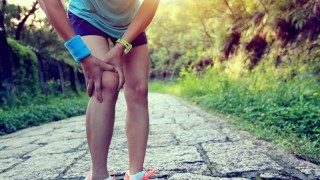
This article first appeared on Triathlete.
The Symptoms
Pain, swelling and stiffness in the knee and an inability to use the joint as much as desired.
What’s Going On In There?
Arthritis is simply the wearing out of a joint’s lining, leaving bone to grind on bone. It’s caused by a combination of factors, including old injuries, genetic predisposition, overuse and sometimes just bad luck.
Arthritis gets worse over time, but it’s possible to continue at your current level of fitness. Find ways to train and maintain fitness while reducing the wear and tear on your knees.
Fix It
Build super legs. If you rest or scale back on your activity level, you lose muscle and the condition worsens. I suggest biking and swimming to build leg strength. Quad-, hip- and glute-strengthening exercises are musts. Multidirectional lunges as well as squats, squat jumps and squat thrusts once you’re able to do them are all good muscle builders.
Fix foot mechanics. Pronation (when the foot turns inward as it strikes) puts extra pressure on the knee joint. Arch supports and stability shoes can help relieve excess knee pounding. Also, try to shorten your stride and raise your foot strikes to 90 per minute.
Try supplements. There is not scientific data to prove the benefits, but many of my patients report that glucosamine and chondroitin help with arthritis pain.
Try an NSAID. An anti-inflammatory like ibuprofen or naproxen can help with pain and swelling.
Change the conditions. If possible, switch to a softer running surface. Blacktop is softer than concrete, dirt and grass are softer than blacktop, and the all-weather track is best of all.
When To Call A Doctor
If you suspect you have arthritis in your knee, it’s a good idea to see a sports doctor, who can verify it easily with an X-ray (which is a better diagnostic tool for arthritic joints than an MRI). A full-on assessment of biomechanical factors such as strength, flexibility and foot mechanics, as well as of external factors such as shoe type, running surface, bike fit and training regimen, can be a huge help.
A doctor can also administer more aggressive treatments if warranted. For example, prescription anti-inflammatories and injectable forms of hyaluronic acid (a substance that occurs naturally in cartilage and helps cushion joints) can help alleviate symptoms.
Last, since arthritis is a degenerative condition, it’s a good idea to see a doctor early in its course to establish a baseline for your condition. Your doctor can use it to assess later changes as he or she continues your care.
Do You Need Surgery?
Generally, no. As you
get older, however, knee replacement surgery may be an option if your condition no longer responds to regular therapies.
RELATED: Running Knee Injuries 101
The post How Runners Can Treat and Prevent Knee Arthritis appeared first on Competitor.com.
Out There: The Fine Line Parents Must Run

Yesterday, a friend of mine sent me a link to an article from a German news site.
“Get a load of this,” she said.
Because the story was in German and my knowledge of the language is limited to Ich bin ein jelly donut, I inferred any and all knowledge from the accompanying photo of parents and children on a track.
“Oh, that’s cute,” I said. “Parents and kids running together!”
“Look closer,” she replied.
When I actually paid attention, I gasped. “Are…are they dragging their kids down the track?”
After employing the services of Google Translate, I read a patchy English version of the story of a 40-meter dash for 3- and 4-year olds:
“The children were flown at the hands of parents two feet high in the air…since the parents wanted to win. The children were crying.”
That’s right, the kids weren’t racing. They were being dragged by their über-competitive parents.
Wie bitte? That’s not okay, my little jelly donuts.
Anyone who thinks this behavior is limited to our Deutschland friends is delusional. Go to almost any kids’ sporting event in America, and you’ll see your very own episode of Parents Gone Wild. Some children aren’t children anymore, but an extension of Mom and Dad’s unrealized athletic dreams. Their parents sit behind home plate at little league games with radar guns, clock splits at the track, and insist to all who will listen that their kid is headed for a full-ride athletic scholarship as soon as these cute little front teeth grow in.
Not all parents are glory-seeking psychos, I know. But they are definitely a growing subset of the Mom and Dad crowd. That’s a scary thing for the kids.
As a child, I hated running. I only ran when I had to, and I only had to once a year, when our gym teacher made us run the mile for fitness testing. She’d stand at the top of the hill behind our school, using a megaphone to blast encouragement at us:
“YAY, EAGLES! BOO, TURKEYS!”
The athletic kids, who finished quickly and barely broke a sweat, were eagles. She’d send those kids back out onto the mile course to taunt the turkeys to the finish line. It should go without saying that I was very much a turkey. The experience was enough to turn me away from running for a long (looooong) time.
And that was just gym class. Imagine if my parents had been the ones putting the pressure on me. If I associated running with being dragged 40 meters while crying, I wouldn’t be writing for a running magazine today; I’d probably be manning the hotline at Butterball.
It wasn’t until much later, when I was an adult, that I learned that running could be fun. (I know! This discovery shocked me, too!) For too long, I had associated running with something I had to be good at in order to participate. People run to win, and I was not a winner. I was a turkey.
But then a friend convinced me to train for a 5K—no pressure, just for fun. On race day, I was nowhere near the top podium spot, and I did not care. When I crossed that finish line, I felt like a winner anyway. And then I felt sad, because why should anyone have to wait that long to feel that good?
There are a lot of lessons kids can learn from running. “It’s painful and sucky” should not be one of them. Let’s stop screwing up what should be a positive experience.
As parents, we want our kids to be great. Of course we do! But we don’t get to force them to be great on our terms. Maybe little Joanie is an eagle. Or maybe she’s a turkey. You don’t get to decide. Just because you once held the school record for the 200-meter dash doesn’t mean you get to force your son into a pair of track spikes to carry on the family honor. It certainly doesn’t mean you should drag him (kicking and screaming, no less) so you can have bragging rights.
We grown-ups had our shot. Now let the kids have theirs. While we’re at it, let’s all have some fun.
* * *
About The Author:
Susan Lacke does 5Ks, Ironman Triathlons and everything in between to justify her love for cupcakes (yes, she eats that many). Susan lives and trains in Salt Lake City, Utah with three animals: A labrador, a cattle dog, and a freakishly tall triathlete husband. She claims to be of sound mind, though this has yet to be substantiated by a medical expert. Follow her on Twitter: @SusanLacke.
The post Out There: The Fine Line Parents Must Run appeared first on Competitor.com.
April 6, 2016
Price Isn’t Everything When Buying Running Shoes
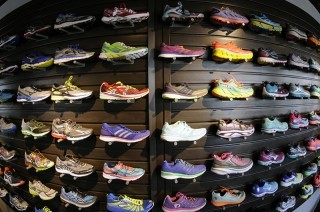
Local running stores are about more than just selling shoes; they're all about community, says Fleet Feet Sacramento owner Pat Sweeney.
Running stores are the heart and soul of running.
Inspiration greets you the moment you walk in the door. More than just a place to buy new running shoes, small, independent running stores are all about community, says Pat Sweeney, the co-owner of Fleet Feet Sports in Sacramento, Calif. They offer things you can’t get by clicking a mouse—namely service, support and a passion for running and local runners.
But increasingly for the past 10 years, small, independent running stores have been losing sales to the online vendors—online running shoe stores, sites that are selling discounted shoes from previous years and even directly from the same shoe brands they are selling in their stores.
Sweeney wrote a passionate article for the Washington Post this week about why small, independent running stores are the lifeblood of the running community.
“What drives us isn’t offering products at the lowest cost,” he writes. “We have never, and will never, win on price. And we don’t want to, thank you very much. That’s a race to the bottom that offers no prize.
“What does drive us continues to be that customer who comes through the door in search of answers for her aching feet; the customer who comes to us looking for help in setting a new personal record; or the customer who shows up on a cold Tuesday night to his training program, ready to run a mile without stopping for the first time in his life.”
Not only do those stores support local runners, but they also support local schools, races and training programs.
READ MORE: Washington Post
RELATED: Reasons to Avoid Buying Cheap Running Shoes Online
RELATED: 10 Reasons Why You Should Shop at a Running Specialty Store
The post Price Isn’t Everything When Buying Running Shoes appeared first on Competitor.com.
Workout of the Week: Lee Troop’s Progressive Long Run

Photo: Shutterstock.com
Lee Troop knows a few things about the marathon. The 42-year-old Boulder resident was a three-time Olympian for Australia and holds a personal best of 2:09:49 for the distance. He’s now the high performance coach for the Boulder Track Club and works with some of the best marathoners in the United States. Reigning national cross country champion Laura Thweatt made her 26.2-mile debut in New York last fall a memorable one, finishing seventh overall and top American in 2:28:23. Sean Quigley, who ran his personal best of 2:13:30 under Troop, recently finished ninth at the Olympic Trials.
One of Troop’s key marathon-specific workouts for his charges is a progressive long run done three weeks out from race day. Here are the key details:
WHAT: An 18-mile long run that starts off easy and gets faster every 3 miles. The last 6 miles are completed at goal marathon pace. E.g., If your goal marathon pace is 7:30 per mile, begin the run with 3 miles at an easy training pace. Then run miles 4-6 at 8:15 per mile, miles 7-9 at 8:00 per mile, miles 10-12 at 7:45 per mile, and the last 6 miles at your goal marathon pace of 7:30 per mile.
WHY: “It gives me a really good indication of what they’ll be able to hit [on race day],” Troop says. “If they hit it, we can go into the last couple weeks [of training] with a lot of confidence.”
WHEN AND HOW: Troop has his athletes complete this challenging workout three weeks out from their goal race. “This is one of the last hard workouts we do,” explains Troop, who adds about 5-8 seconds per mile for his athletes when they’re training at altitude. “And it’s done off a fairly heavy block of training leading into it, so it’s just the right amount of stress.”
RELATED: Marathon Tapering Tips From Lee Troop
The post Workout of the Week: Lee Troop’s Progressive Long Run appeared first on Competitor.com.
2016 Rock ‘n’ Roll Las Vegas Registration Opens
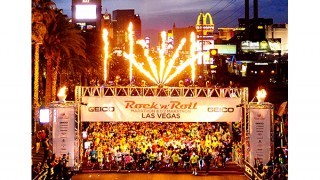
The world’s largest nighttime running event is back in 2016—and it’s time to sign up.
The Rock ‘n’ Roll Las Vegas Marathon and 1/2 will take place Nov. 12-13 on the Las Vegas Strip. It is the one of only two times the entire year that Las Vegas Boulevard closes (the other being New Year’s Eve). Registration is open for the marathon and half marathon, and will open for the 5K and 10K at a later date.
Forbes Travel Guide recently listed Rock ‘n’ Roll Las Vegas as one of the 12 best marathons in the world to travel for, and Competitor listed it as one of 15 bucket-list marathons in the United States. The course takes runners on a nighttime tour of Sin City, from the famous Las Vegas sign to the fountains of the Bellagio and the Mirage volcano near the finish line.
“The experience of running down the Las Vegas Strip at night is unparalleled in the event industry,” said Kevin LaRue, Event Marketing Manager. “This combination of a world-class race course under dazzling lights with live, non-stop entertainment from start to finish, provides an opportunity for participants from around the globe to come together to celebrate their physical achievements in epic fashion.”
Marathon and half marathon registration opens at the guaranteed lowest rate of the year. Register at RunRocknRoll.com/Las-Vegas
The post 2016 Rock ‘n’ Roll Las Vegas Registration Opens appeared first on Competitor.com.
Shoe Of The Week: Saucony Kinvara 7
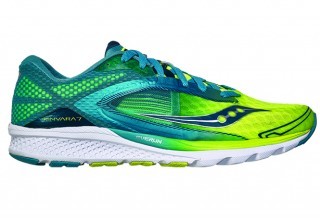
The Kinvara has undergone key changes that make it a better shoe. Photo: Mark Doolittle
The Kinvara has undergone some modifications since last year. Don’t worry, Kinvara lovers, Saucony has only subtly tweaked this lightweight neutral trainer, and the changes are all for the better. Most notably, the new Kinvara has an additional layer of next-generation Everrun foam (an expanded TPU material) in the heel that helps absorb impact and, our testers thought, add a touch of rearfoot stability by easing the foot strike force and smoothing out the transition of the foot through the stride. There’s a new outsole pattern aimed at a smoother, forward-focused flex and a few more patches of rubber for added durability. Despite the notable changes, this shoe retains the consistently soft, smooth and very flexible ride it’s always had. It’s still super light, plenty soft and extremely versatile for strong-legged, efficient runners. If you’re a runner who typically runs in one shoe for all of your training, this is a good choice. Use it for short, fast speed sessions or take it for the long run. Some wear-testers thought it was too a tad too soft, but those who liked it generally loved it.
This is the shoe for you if … You’re looking for a lightweight and versatile everyday trainer with a low heel-toe drop.
Price: $110
Weights: 7.7 oz. (men’s), 6.6 oz. (women’s)
Heel-toe offset: 4mm; 22mm (heel),18mm (forefoot)
RELATED: Shoe Of The Week: Hoka One One Vanquish 2
The post Shoe Of The Week: Saucony Kinvara 7 appeared first on Competitor.com.
April 5, 2016
Adidas Unveils 2016 Boston Marathon Adizero Adios Boost 3
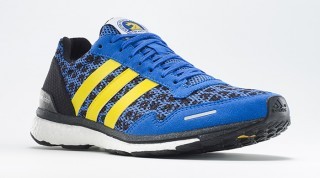
Every year, shoe manufacturers create special edition models for the Boston Marathon. Adidas, the official footwear and apparel sponsor of the race, has unveiled the 2016 Boston Marathon version of its low-profile adizero Adios Boost 3 racing flat. It features a Boston Athletic Association print on the open mesh upper, along with the official B.A.A. logo on the top of the tongue and “Boston 2016” printed on the footbed. The shoe will be available in two colors—the iconic B.A.A. blue and yellow and adidas Equipment Green to commemorate the 25th anniversary of the brand’s equipment line and the first adidas Boston Marathon Anthem Jacket. The shoes will be officially unveiled at a launch party on April 7 at the Boston Marathon adidas RunBase store at 855 Boylston Street in Boston and also be sold at the 2016 John Hancock Sports & Fitness Expo in the days prior to the April 18 Boston Marathon. The adizero Adios Boost 3 weighs 7.9 ounces for a men’s size 9.0 and has a 10mm (23mm/13mm) heel-toe offset.
RELATED: 2016 Boston Marathon Special Edition Shoes
Photo Gallery
1 of {count}
Back to Start
View Larger Image

Adidas adizero Adios Boost 3, $160
View Larger Image

Adidas adizero Adios Boost 3, $160
View Larger Image

Adidas adizero Adios Boost 3, $160
View Larger Image

Adidas adizero Adios Boost 3, $160
View Larger Image

Adidas adizero Adios Boost 3, $160
View Larger Image

Adidas adizero Adios Boost 3, $160

More Galleries
The post Adidas Unveils 2016 Boston Marathon Adizero Adios Boost 3 appeared first on Competitor.com.
April 4, 2016
Don’t Sweat It: Marathon Fueling Made Simple
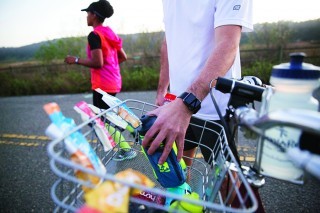
If you were to randomly survey 10 marathoners about their biggest concerns heading into a goal race, it’s a good bet that at least half of them would list bonking or dehydration as their top worries. It makes sense—26.2 miles is a long way to run and a long time for your body to be working at an elevated level.
Executing an effective fueling and hydration strategy is a crucial element in races lasting more than two hours, both because you can easily get dehydrated during that time and you will burn through your glycogen (or energy) stores if you aren’t re-
fueling. For that reason, running a marathon is much different than running a half marathon.It is very important to have a fueling strategy heading into a marathon, but putting an emphasis on specific amounts of fluid and a precise number of calories can overcomplicate things—partially because there isn’t an exact science to fueling for a marathon. Also, there are many variables that can alter your body chemistry on race day—what you ate for breakfast, how hydrated you were to start the race, along with the race-day temperature and humidity level.
Lee Troop, a three-time Australian Olympian and high-performance coach for the Boulder Track Club, says that the last thing you want to worry about on race day is whether or not you ingested a specific number of calories or amount of fluid. The most crucial thing during a race is that you are taking in fluids at every aid station.
“It’s an important consideration,” Troop says of fueling and hydration during a marathon. “But we don’t want to overcomplicate it. Throughout the race, it’s mainly just hydration and topping off the tank.”
Proper nutrition and hydration for the marathon can be confusing concepts because there’s an overwhelming amount of information available out there about things like nutrient timing, simple and complex carbohydrates, and high- and low-glycemic foods. Not to mention a myriad of complex formulas for determining how much to eat and drink, plus an endless grocery list of food suggestions and fueling strategies aimed at helping you achieve optimal energy levels. It’s a lot to digest.
The truth is, every runner has different and specific nutritional needs for optimal performance. The best ways to find out what works for you are by experimenting through trial and error, and making fueling practice a regular part of your marathon-specific workouts. Simulating race-pace scenarios in practice is the best way to do that, says Ben Rosario, head coach of the Hoka Northern Arizona Elite training group.
“What’s getting you to the finish line is being efficient at marathon pace and getting economical at that rhythm—not how many carbs you get in during the race,” Rosario says.
Over the following pages, Rosario and Troop shed some light on three tried-and-true approaches for developing an effective marathon fueling and hydration strategy. Apply them to your own training, so that when you step to the starting line of your next big race, your biggest concerns don’t revolve around how much you should eat and drink.
RELATED: Fueling For Your First Marathon
The post Don’t Sweat It: Marathon Fueling Made Simple appeared first on Competitor.com.
Boston-Bound: Peaking For The Big Race With 2 Weeks To Go!

The energy of Boylston Street awaits you! Photo: PhotoRun.net
Let’s get ready to race! The last two weeks before Boston are a time to let the body and mind freshen up. This has been shown to help athletes peak for their goal race, which is why it’s called the peaking phase.
It’s an easy concept: You reduce your training volume as the race nears and the body restocks its energy stores and fully recovers from the previous weeks of hard training. Your mind also recharges so that on race day, you are physically and mentally ready to race your best.
But, there is an art and science to peaking properly. In this article, I’ll share my secrets to peaking for Boston.
Week 11
Week 11 is like the “down” weeks you experienced every few weeks throughout this 12-week training cycle. You should reduce your training volume by around 20 percent compared to your normal weekly mileage. It’s helpful to maintain your frequency (i.e., run the same number of days per week) in this first peaking week so the reduction in training volume comes from running shorter on your run days than you normally would.
The only exception to the plan of running the same number of days per week is if you have an ache or pain that you are worried about. In this case, take an extra day off in Week 11 in addition to reducing your total training volume (and schedule a physical therapy or massage appointment if you haven’t already). This may mean your reduction is more like 25-30 percent but I like using this week as way to ramp up healing now that you have the big workouts behind you.
While reducing volume is one part of the peaking process, the other part is keeping your engine revved. This maintenance (or sometimes increase) in training intensity has been shown to help athletes peak on time. My experience has been that maintenance of training intensity is more for the mind than the body. If you back off your intensity and volume, your mind can become “soft” and you forget the toughness you’ve worked so hard to create with all the hard workouts over the previous weeks.
For Week 11, I advise one of two key workouts based on the type of runner you are. If you love steady, continuous workouts, then you should do a tempo run as your workout in Week 11. The goal here is not to run faster than previous tempo runs. The goal is more to see just how relaxed you can run at your tempo run pace. (See the McMillan Calculator to get your exact pace.)
In the peaking phase, we aren’t trying to build more fitness. We are trying to refine the fitness you have, and the fitter you are, the more careful you need to be in these last few workouts. Don’t leave your race in training!
If you are more of the speedster type and like repetitions and perform better in shorter races, I suggest you skip the tempo run and instead perform a tempo interval workout. Again, don’t push too hard—just get in a solid workout. Run as relaxed and smoothly as possible.
For your long run, I’ve had great success with an easy six miles followed by six miles at goal marathon pace (12 miles total) 7-9 days before the race. You get in a few miles to keep your body in the usual weekend long run rhythm but it’s shorter than your previous long runs so you recover quickly. As a bonus, you get the chance to again practice your goal pace and your equipment and nutrition during this last long run. This seems to work well to keep runners from doing too much but also helps them put the finishing touches on their race practice.
Workout No. 1 (endurance-oriented runners): Tempo Run. Warm up with 10-20 minutes of easy jogging, then run a 3-5 mile tempo run. Cool down with 10-20 minutes of easy jogging.
Workout No. 1 (speed-oriented runners): Tempo Intervals. Warm up with 10-20 minutes of easy jogging, then run tempo intervals of 3 x 2000 meters with 400 meters jogging recovery between reps. Cool down with 10-20 minutes of easy jogging.
Workout No. 2 (advanced runners, early in week): Fartlek. Warm up with 10-20 minutes of easy jogging, then run a light fartlek of 6-8 x 1:00 at around 5K effort followed by a 1:00 recovery jog. Cool down with 10-20 minutes of easy jogging.
Long Run: 12 miles. Run 6 miles at your long run pace then run you final 6 miles at goal marathon pace
Week 12
Race week!
Race week continues our freshening up of body and mind as we head toward marathon Monday. You should again reduce your volume by another 10-20 percent for the days leading in to the marathon. Note that your total for the week will be quite a bit lower than your previous week since you won’t have the long run or the marathon (due to the Monday race day) so focus less on the reduction in total mileage for the week and more on the reduction in daily volume. And, really taper down the last few days before the race. I like to run 20 minutes or so the day before the race (Sunday) and 20-30 minutes two days before the race (Saturday).
For workouts, again, I think there are two different optimal workouts depending on your runner type. If you are the endurance monster type, then do another tempo run. If you are more of a speedster, then do cruise intervals. Both work great to give you just enough of a stimulus on race week but not too much.
Workout No. 1 (endurance-oriented runners): Tempo Run. Warm up with 10-20 minutes of easy jogging then run a 2-3 mile tempo run. Cool down with 10-20 minutes of easy jogging.
Workout No. 1 (speed-oriented runners): Cruise Intervals. Warm up with 10-20 minutes of easy jogging, then run cruise intervals of 4-5 x 1000 meters with 200-400 meters of jogging recovery between reps. Cool down with 10-20 minutes of easy jogging.
Workout No. 2 (advanced runners, early in week): Light Fartlek. Warm up with 10-20 minutes of easy jogging, then run a light strides workout of 6-8 x 20-30 seconds at around 5K effort followed by 1:00 of jogging recovery. Cool down with 10-20 minutes of easy jogging.
After each run this week, feel free to do a few strides (50-100 meters accelerations at just faster than 5K pace) if you feel you need some faster work to burn off excess energy during the peaking phase. As always, don’t over do it but if it feels good, it’s probably good for you.
The post Boston-Bound: Peaking For The Big Race With 2 Weeks To Go! appeared first on Competitor.com.
8 Blister-Busting Items for Happy Feet
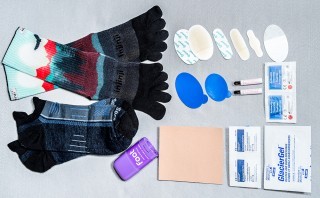
The unwelcome tingle of a blister is a common complaint among runners, but there are solutions: Make sure shoes fit properly and that sweaty feet can breathe. But most importantly, do what works for you. If you are blissfully blister-free, keep doing what you’re doing! For those who aren’t, here are some of the best preventive and protective options for happy feet.
Photos: Mark Doolittle
Photo Gallery
1 of {count}
Back to Start
View Larger Image

REI Tincture of Benzoin, $7.50 for package of 6
Made from tree sap and alcohol, this super-sticky compound goes on skin to create a tough blister barrier—or, if you already have a blister, it can be used to help bandages adhere better, even in sweaty shoes or socks. Single-use vials make it less messy, and easy to carry.
View Larger Image

Body Glide Foot, $8
Body Glide added vitamins A and C, as well as apricot and comfrey leaf essential oils (to help calm inflammation and moisturize dry skin) to the same long lasting, sweat resistant, breathable, plant-based waxes used in the original formula, which helps stop blisters and hot spots before they begin.
View Larger Image

Compeed Blister Cushions Variety, $8
Stick this moisture-absorbing cushion to blistered or tender skin for a protective barrier that stays in place for days, making it ideal for long runs and breaking in new shoes. It’s like an instant callus that’s easy to remove.
View Larger Image

Engo Blister Prevention Patches, $14 for oval 6-pack
What do you do when it’s not you, but your shoes—a rough seam, worn heel pocket or odd spot between the insole and shoe? These thin, latex-free patches stick to shoes to reduce uncomfortable rubbing and stay put for up to 300 miles.
View Larger Image

Adventure Medical Kits Blister Medic, $10
Sold as an all-in-one package, the Blister Medic pack includes a variety of Moleskin pads (pictured), Glacier Gel pads, antiseptic towelettes and antiseptic wipes.
View Larger Image

Blist-O-Ban Bandages, $8 for package of 4
These unique bandages have a dome to fit over blisters and redirect friction away from the area. Made of thin, breathable, water-resistant material, they can also be used in problem spots to prevent blisters from forming.
View Larger Image

Wrightsock Endurance Socks, $15
Double-layer construction means the sock—not your foot—absorbs shoe friction. In addition to having a smooth feel, these socks also have padded tabs at the heel and ankle to protect against high ankle collars.
View Larger Image

Injinji Spectrum Run Lightweight No-Show Socks, $14
Injinji toe socks have individual, soft-knit pockets for each of your tootsies, meaning you can say goodbye to painful between-the-toes blisters. The lightweight, low-bulk fabric makes this a good style for toe-sock newbies.
Related Galleries

4 Common Problems For Runners (And How To Handle ‘Em!)

More Galleries
The post 8 Blister-Busting Items for Happy Feet appeared first on Competitor.com.
Ryan Hall's Blog
- Ryan Hall's profile
- 21 followers



